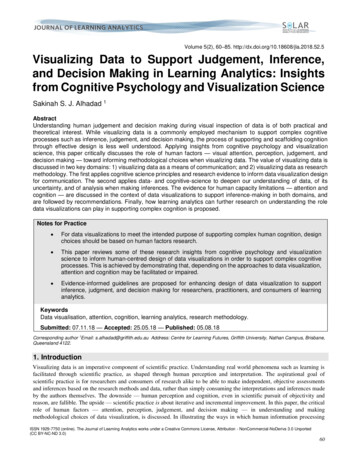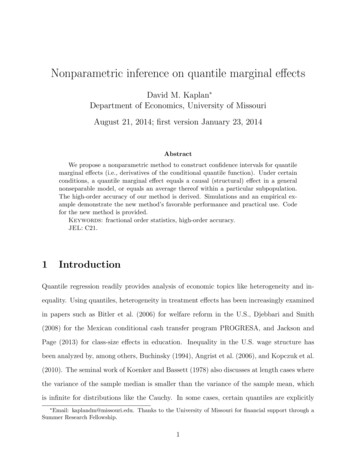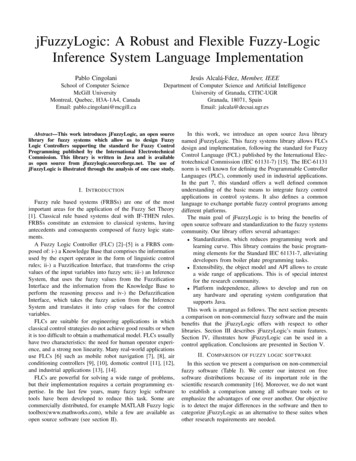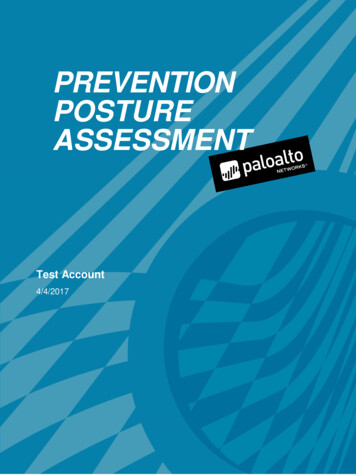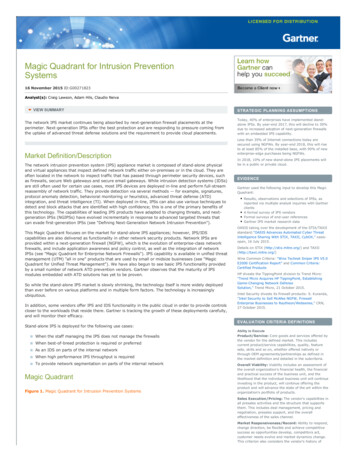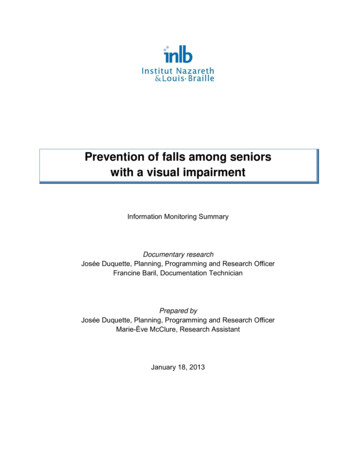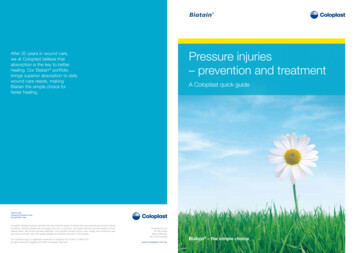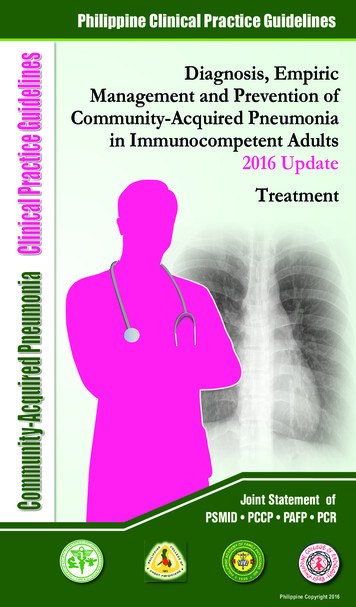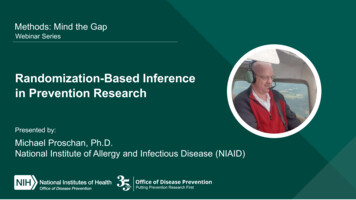
Transcription
Methods: Mind the GapWebinar SeriesRandomization-Based Inferencein Prevention ResearchPresented by:Michael Proschan, Ph.D.National Institute of Allergy and Infectious Disease (NIAID)
Hail Randomization Randomization is what separates clinical trials from allother studies Key property: Randomization eliminates bias in whoreceives treatment– In observational studies, people who choose an experimentalintervention may be different (e.g., more health conscious) thanthose who don’t– In a randomized trial, a coin flip decides2
Analyze as YouRandomize Principle Randomization can also be the sole basis for decidingwhether the intervention works This randomization-based inference is sometimes calledthe analyze as you randomize principle Invented by Fisher (1935) in connection with the “ladytasting tea” experiment3
“Tea” Test A lady claims she can tell whether cream or tea was addedfirst to a cup Experiment: add tea first to 4 cups, cream first to 4TTTTCCCC Present cups in random order4
“Tea” Test A lady claims she can tell whether cream or tea was addedfirst to a cup Experiment: add tea first to 4 cups, cream first to 4CTTCCTTC Present cups to the lady in random order The lady guesses which cups had cream added first Count the number correct among the cream first cups Suppose she correctly guesses 2,4,7,8 had cream added first5
“Tea” TestCup:12345her guess678The null hypothesis is she is guessing (guesswould have been the same regardless ofrandom order)6
“Tea” TestCup:Truth:1T2C3T4C5Ther guessT tea firstC cream first6T7C8CThe null hypothesis is she is guessing (guesswould have been the same regardless ofrandom order)7
“Tea” TestCup:Truth:1T2C3T4C5Ther guessT tea firstC cream first6T7C8CThe null hypothesis is she is guessing (guesswould have been the same regardless ofrandom order)Number correct among cream first cups: 48
“Tea” Test How can we obtain a reference distribution of numbercorrect under the null hypothesis that she is completelyguessing?– Consider all possible orderings of the cups9
“Tea” TestCup:What-if:1T2T3T4T5Cher guessT tea firstC cream first6C7C8CThe null hypothesis is she is guessing (guesswould have been the same regardless ofrandom order)Number correct among cream first cups: 210
“Tea” TestCup:What-if:1C2C3T4T5Cher guessT tea firstC cream first6C7T8TThe null hypothesis is she is guessing (guesswould have been the same regardless ofrandom order)Number correct among cream first cups: 111
“Tea” Test Do for all possible orders to get a null reference distribution ofnumber correct P-value: proportion of randomizations producing at least asmany correct guesses as she got among cream first cups Called a randomization test (AKA re-randomization test orpermutation test) She got all 4 cream first cups right12
13
14
How Is This Connected to Clinical Trials? T and C are now treatment and control instead of tea or cream first Data are now dead or alive instead of the lady’s guesses Randomize patients to T or C using random permuted blocks: For a block of size 8, have 4 cards with “T” (Treatment) and 4 with “C”(Control)TTTTCCCC Randomly permute the order and assign next 8 people15
How Is This Connected to Clinical Trials? T and C are now treatment and control instead of tea or cream first Data are now dead or alive instead of the lady’s guesses Randomize patients to T or C using random permuted blocks: For a block of size 8, have 4 cards with “T” (Treatment) and 4 with “C”(Control)CTTCCTTC Randomly permute the order and assign next 8 people16
Clinical TrialPeopleTruth:1T2C3T4C5T6TdeadT treatmentC control7C8CThe null hypothesis is people who were goingto die would have died, no matter what theywere randomized toNumber dead among control-group: 417
Clinical TrialPeopleWhat if:1T2T3T4T5C6CdeadT treatmentC control7C8CThe null hypothesis is people who were goingto die would have died, no matter what theywere randomized toNumber dead among control-group: 218
Clinical TrialPeopleWhat if:1C2C3T4T5C6CdeadT treatmentC control7T8TThe null hypothesis is people who were goingto die would have died, no matter what theywere randomized toNumber dead among control-group: 119
20
Fisher’s Exact Test In this example, the event does not have to be death (anybinary outcome) Example had 4 deaths, but method works regardless of thenumber of deaths Data remain fixed; only the treatment labels are random This is called Fisher’s exact test21
Randomization Test1. Treat the data as fixed (nonrandom) numbers andcompute the observed treatment effect2. Re-randomize using the same method used in the trial3. Compute the treatment effect pretending the rerandomized assignments were the real assignments4. Repeat steps 1-3 a huge number of times5. P-value: proportion of re-randomized trials with anintervention effect at least as extreme as observed effect22
Randomization Test Premise: if intervention has no effect, then observedresults are equally plausible regardless of interventionand control labels Randomization test works with different data types(continuous, categorical, and so on) Provides a valid test with NO assumptions23
Randomization Test Most statistical methods assume participants arerandomly sampled from the population of interest How often does this happen in clinical trials? Never!– We don’t have a list of all people who have a disease– Even if we had a list and sampled randomly from it, noteveryone would consent Even though we never randomly sample, we alwaysrandomize24
Randomization Test A randomization test tests the strong null hypothesis that theintervention has no effect on anyone– Important caveat because it could come out statistically significant iftreatment has an effect on the variance, but not the mean– Even more important caveat if randomization tests are used and anunplanned change in design occurs before breaking randomization A randomization test can be used with any randomizationmethod25
Randomization Test Randomization methods––––Simple (fair coin flip for each patient)Permuted block (randomly permuting blocks with half T, half C)Stratified (permuted blocks separately within subgroups)Covariate-adaptive (CAR), AKA minimization or dynamic allocation Use covariate info on next patient to see which assignment maximizesbalance; favor that assignment in randomization– Response-adaptive (RAR) Use outcome data to change probabilities to favor treatments performingbetter Lead us not into the temptation of RAR! (Proschan and Evans, 2020)26
Covariate Adaptive Randomization E.g., suppose have factors gender and hypertensionstatus, & so far:Gender (G)Hypertension (H)MFYesNoT 10385C 8365Imbalance G imbalance H imbalance27
Covariate-Adaptive Randomization (CAR)Next patient is male, non hypertensiveGender (G)MFT 103C 83Hypertension (H)YesNo8565I G imbalance H imbalanceIf next patient is T, imbalance 11-8 6-5 4If next patient is C,imbalance 10-9 6-5 2More balance if we assign to the control, so flip an unfair coin with P(C) 2/328
Response-Adaptive Randomization (RAR)InterventionControlInterventionControl29
COMMIT Randomization tests can also use in a paired setting suchas the Community Intervention Trial for SmokingCessation (COMMIT investigators, 1995)– Pair-matched 22 communities based on geographic location,size, and sociodemographic factors– Randomized one member of each pair to no intervention, andthe other to an intervention to help smokers quit– Primary outcome in each community was the proportion of 550 heavy smokers aged 25-64 who quit smoking30
COMMIT The data in one of the pairs wasICD I-CPair 1 0.204 0.249-0.045 If intervention has no effect, the data should be equallyplausible if we switch I and C labels:D I-CCIPair 1 0.204 0.249 0.04531
COMMIT The randomization distribution for this pair is -0.045 or 0.045with probability ½ each Similarly, each pairwise difference is equally likely to be d or–d The null reference distribution is obtained by computing themean of the 11 paired differences for every possible relabeling P-value was p 0.686 P-value for t-test was p 0.685 What a coincidence!32
Spoiler Alert This was NOT a coincidence! For traditional randomization methods, when sample sizesare large, the randomization and t-tests give nearly the sameanswer (in COMMIT, 11 was large enough!) Works because the test statistic is like a sum of or –deflections of roughly equal size Think about a quincunx, AKA Galton board ( 35 at Amazon)33
ApproximatelyNormal34
Temporal Trends A randomization test protects against temporal trends In trials in emerging infectious diseases, baseline healthcan change dramatically over time because of– Evolution of the virus– Better background care– Introduction of vaccines35
COVID-19Asch et al. (2021) JAMA Intern Med. 181, 471-47836
Temporal Trends A bad randomization method can be subject to bias from temporaltrends Example of a bad randomization method:– Use 1:4 randomization to T or C in first half of trial, then use 4:1 in thesecond half Suppose there is a temporal trend from 1st to 2nd half Most controls were in first half, most treated patients were in secondhalf, so treatment effect is confounded by time37
Temporal Trends Chance of a false positive can be elevated with somestandard analysis methods A randomization test automatically handles temporal trends– Temporal trends will occur in the re-randomized trials as well– To reach statistical significance, the observed effect has to be largeenough to be distinguishable from a possible temporal trend Note: this randomization method was foolish, but similarthings can happen with response adaptive randomization(RAR) and did happen in one trial using covariate adaptiverandomization (CAR)38
Eye-Opening Experiencefor Minimization October 2008 FDA Advisory Committee meeting onPompe disease– Very rare, debilitating neuromuscular disease Infant onset, juvenile onset, adult onset– Infant onset is most deadly, adult onset is still bad– Patients often progress to wheelchair dependence, ventilator,and death39
Eye-Opening Experiencefor Minimization Genzyme conducted Late Onset Treatment Study (LOTS) 90 patients with late onset Pompe disease Primary outcome: 6 minute walk test 2:1 allocation to drug/placebo using CAR Site BL 6 minute walk ( 300m, 300m) Forced vital capacity ( 55% pred., 55% pred.) One analysis: randomization test40
ANCOVA p .035Randomization p .0641
Eye-Opening Experiencefor Minimization Notice the mean of randomization distribution is NOT 0– It is 0 for standard randomization methods The nonzero mean tells us that usual analysis methodsmight be prone to confounding if there are temporaltrends A randomization test protects against the confounding42
Eye-Opening Experiencefor Minimization For more details on LOTS trial, see Van der Ploeget al. (2010) For more details about statistical problemsminimization caused, see: Proschan, Brittain, andKammerman (2011). For the fix for CAR with unequal allocation, seeKuznetsova and Tymofyeyev (2012).43
One Question Quiz True or false: A t-test allows generalization to thepopulation, but a randomization test applies only toparticipants in your trial Hint44
Explanation of Quiz Answer The statement is false because generalization is alwayssubjective, regardless of what statistical test is used With large sample sizes, the t-test and randomization testare nearly identical, so how could only one of them begeneralizeable?45
SUMMARY Randomization provides a basis for analysis called theanalyze as you randomize principle– Fix data at observed values and re-generate treatment labels toget the randomization distribution of test statistic Easy to explain to nonstatisticians For large sample sizes and standard randomizationmethods, it is virtually the same as usual t-test or test ofproportions46
SUMMARY Provides a valid test with essentially no assumptions Caveat: it tests a strong null hypothesis of no effect ofintervention on anyone– The observed data would have happened irrespective of therandomizations Can be used with any randomization, but don’t use justany randomization– Avoid response-adaptive randomization47
References Community intervention trial for smoking cessation (COMMIT)(1995). American Journal of Public Health 85, 193–200. Fisher (1935). The Design of Experiments (5th ed.). HafnerPublishing, New York. Kuznetsova and Tymofyeyev, (2012). Statistics in Medicine 31, 701–723. Proschan, Brittain, and Kammerman (2011). Biometrics 67, 11351141. Proschan and Evans (2020). Clinical Infectious Diseases, 71, 3002–3004. Van der Ploeg et al. (2010). NEJM 362, 1396-1406, 2010).48
“Tea” Test A lady claims she can tell whether cream or tea was added first to a cup Experiment: add tea first to 4 cups, cream first to 4 C T T C C T T C Present cups to the lady in random order The lady guesses which cups had cream added first Count the n
